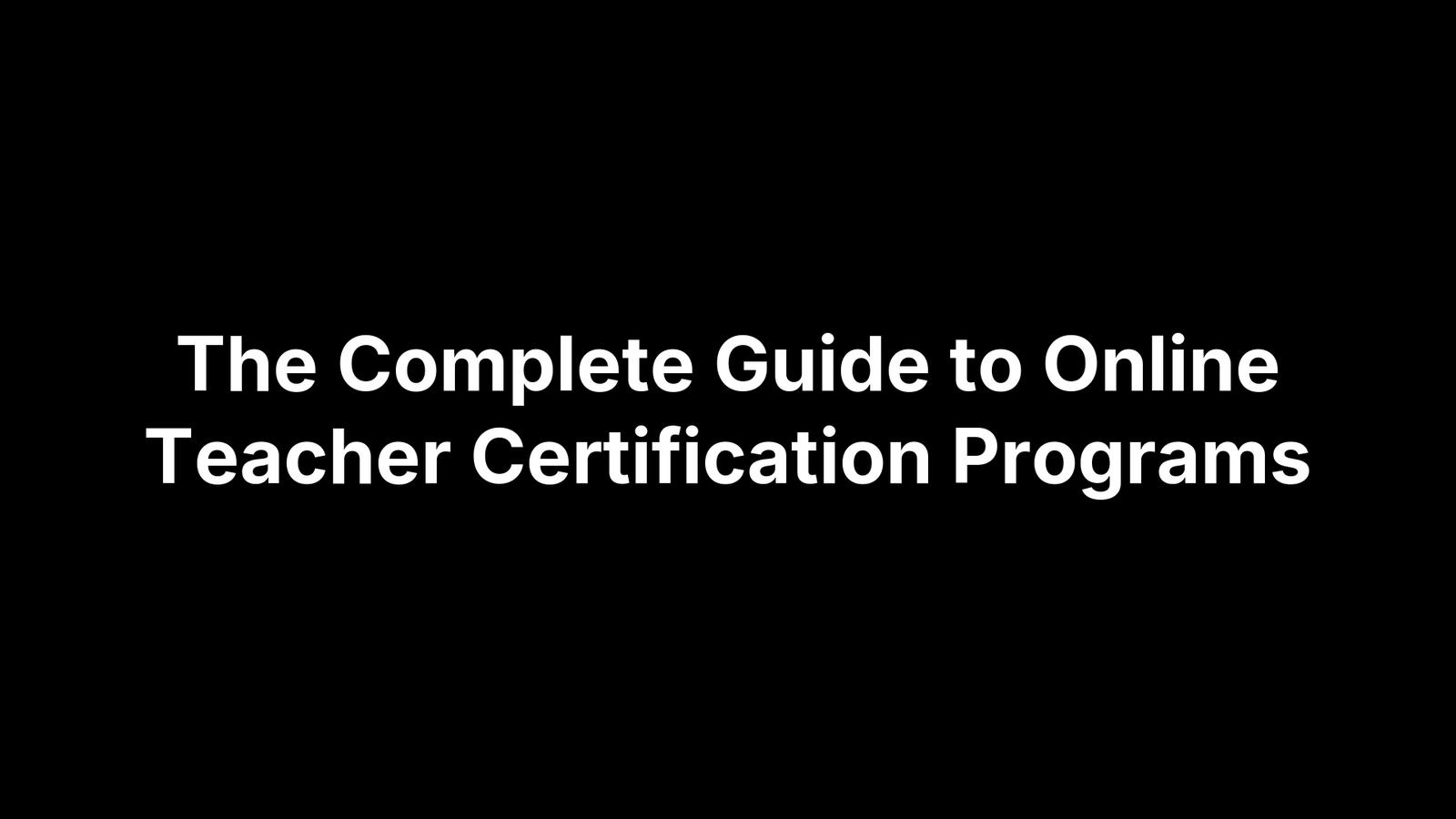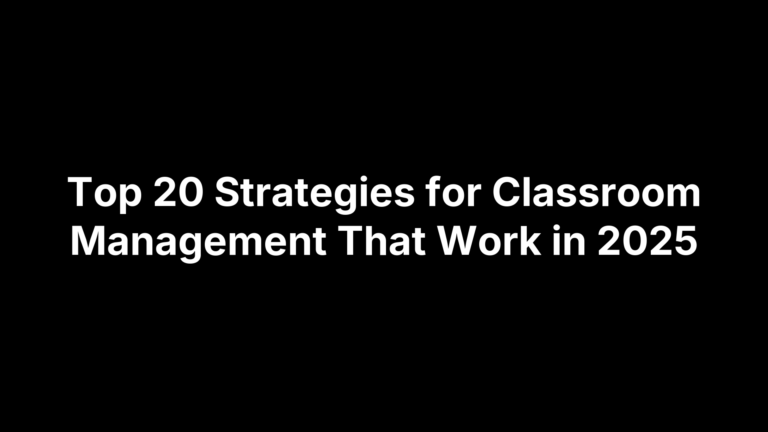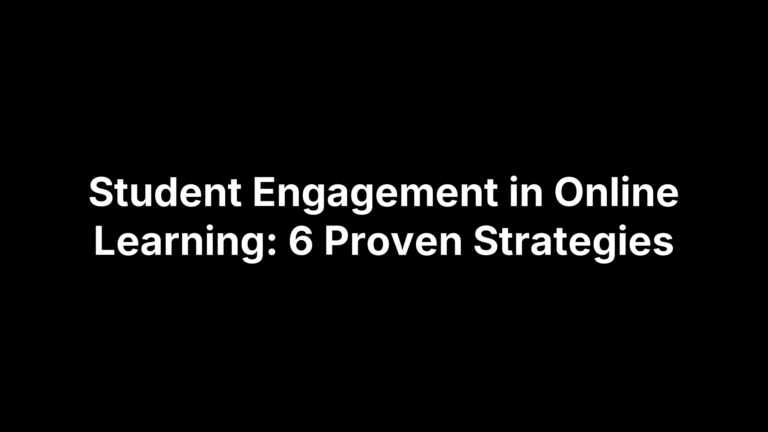The Complete Guide to Online Teacher Certification Programs
You’ve earned a bachelor’s degree, you’re ready to inspire students, and you need a teaching license—without pressing pause on your life. Fully online, state-approved teacher certification programs make that possible by pairing remote coursework with a locally arranged practicum. Most candidates finish in 9–24 months and spend anywhere from about $4,000 for an accelerated alternative route to $25,000 for a graduate-level option, all while meeting the same standards as on-campus cohorts.
Teacher certification is the state’s stamp of approval that you’ve mastered pedagogy, content knowledge, and classroom practice. The rise of distance learning and alternative pathways means there are now dozens of ways to reach that goal, and the rules shift slightly in every state. Which prerequisites matter? How long will the program really take? What hidden fees pop up? How do you confirm a provider is legitimately approved for licensure? This guide answers those questions—and many more—so you can compare programs with confidence and take the fastest, safest route to your own classroom.
Online Teacher Certification at a Glance
Think of an online teacher certification program as a two-part recipe: academic coursework you complete from your laptop and hands-on teaching you complete in a real K-12 classroom near you. The virtual portion covers pedagogy, content methods, and state test prep, while the in-person portion (usually 12–16 weeks) lets you practice under a veteran mentor. Whether the provider is a flagship university, an alternative cert company such as iteach, or even a large school district running its own cohort, every curriculum is vetted by the state’s department of education. In other words, “online” changes the delivery format, not the rigor or the license you earn.
What Sets Online Programs Apart From Campus Options
- Delivery modes: Most coursework is asynchronous—recorded lectures, discussion boards, self-paced modules—so you can log in after work. Some programs add weekly live sessions on Zoom for Q&A or micro-teaching.
- Flexibility: Instead of relocating to a college town, you arrange field hours at a partner school in your zip code, making career changes feasible for parents and full-time professionals.
- Tech ecosystem: Expect a learning management system like Canvas, Blackboard, or Brightspace plus interactive tools such as GoReact for video coaching and Mursion or TeachLivE for avatar-based classroom simulations that let you rehearse management moves without real students.
The Basic Steps From Enrollment to Licensure
Apply → Get admitted → Finish online courses → Complete field/ student teaching → Pass state exams → Submit licensure packet
Most candidates move through this pipeline in 9–24 months, though self-paced models can trim the timeline to under a year for highly motivated learners.
Pros and Cons of Earning Your Certification Online
Before you commit tuition dollars, weigh the perks and trade-offs of completing licensure requirements through distance learning rather than a traditional campus cohort. For many career changers, the flexibility is a lifesaver; for others, the self-directed format can feel isolating.
Key Advantages
- Schedule control: Log in after work, on weekends, or during a child’s nap—no relocation or rigid bell schedule.
- Accelerated pacing: Eight-week blocks and self-paced modules mean motivated students can finish some online teacher certification programs in 6–12 months.
- Lower overhead: Skip commuter costs, housing near campus, and often pay per course instead of per semester.
Possible Challenges and How to Overcome Them
- Self-management: With no professor taking attendance, set weekly goals, use calendar alerts, and buddy up with a peer for accountability.
- Local field placements: Some providers expect you to find your own mentor teacher; start contacting principals early and lean on alumni networks for introductions.
Who Thrives in an Online Certification Environment
Successful candidates are organized, tech-savvy, and proactive communicators. Quick gut check:
- Can I dedicate 10–15 focused hours each week?
- Do I learn well through videos, readings, and discussion boards?
- Will I ask for help instead of waiting for reminders?
If you answered “yes” more than once, the online route is probably a solid fit.
Ensuring Your Program Will Lead to Licensure
Picking the wrong provider can cost thousands of dollars and months of coursework that a state licensing office refuses to recognize. Before you sign anything, verify that the program meets both institutional accreditation and state‐specific approval standards and that its license will travel if you ever relocate. The checkpoints below keep you out of red-tape purgatory.
Accreditation and State Approval Explained
Accreditation confirms an institution’s overall academic quality, while state approval confirms that a specific program meets teacher-prep regulations. You usually need both.
- Institutional accreditation: Look for one of the six regional bodies (e.g., Middle States, SACSCOC) rather than a purely national accreditor. Regional accreditation makes federal aid and graduate credit transfer possible.
- Programmatic accreditation: Many universities pursue CAEP or AAQEP as a quality stamp for education units, although it’s optional in some states.
- State approval: This is non-negotiable. A program must appear on your state Department of Education’s list of approved educator-preparation providers. No approval, no license—no matter how prestigious the college.
Double-check each layer by cross-referencing the school’s claims with public databases and calling the licensing division if anything seems fuzzy.
Understanding License Reciprocity and Portability
Forty-plus states participate in the NASDTEC Interstate Agreement, but reciprocity is rarely automatic. Expect one of three scenarios if you move:
- “Like-to-like” acceptance—your credential converts with minimal paperwork.
- Additional testing—often a Praxis Subject Assessment or edTPA.
- Supplemental coursework—usually in state history, reading methods, or special education law.
Ask whether the program’s completers have successfully transferred licenses to your target state and what extra hoops they jumped through.
Questions to Ask an Admissions Counselor
- Is the program explicitly approved for initial licensure in my state?
- Which regional accreditor covers the institution?
- Is the education unit CAEP- or AAQEP-accredited?
- What percentage of graduates pass the required state exams on the first attempt?
- Who arranges student-teaching placements and in which districts?
- Can I teach on a provisional license while enrolled?
- How many alumni have transferred their license to another state?
- What is the program’s completion rate and average time to finish?
- What tech fees, lab fees, or “internship fees” are not in the tuition quote?
- What supports—test prep, tutoring, career services—are included after graduation?
Program Types and Career Pathways
Not every aspiring teacher starts in the same place, so online teacher certification programs are arranged in several “tracks.” Your academic history, career goals, and timetable determine which lane makes the most sense. Below is a quick primer on the four options you’ll run into while comparing providers.
Initial Certification for First-Time Teachers
These are the digital versions of traditional teacher-prep degrees. Candidates who already hold (or are finishing) a bachelor’s—often in education, English, math, or another teachable subject—complete 30–36 credits of pedagogy and methods, then student-teach for a semester. Upon graduation you apply for an initial license and, in most states, may roll those credits into a future master’s.
Alternative and Accelerated Routes for Career Changers
Post-baccalaureate certificates, teacher residencies, and internship models fall here. You enroll with any accredited bachelor’s, pass a basic skills test, and often receive a provisional license that lets you earn a paycheck as the teacher of record while finishing 12–24 months of online coursework. Self-paced platforms (American Board, iteach, TeacherReady) can be wrapped up in under a year if you move quickly.
Add-On Endorsements and Specialized Certificates
Already licensed but want to pivot to ESL, Special Education, STEM, or Gifted? Endorsement tracks add 12–18 credits plus supervised practice focused on the specialty. Many districts pay stipends for these hard-to-fill roles, so an add-on can boost both employability and salary without starting another full degree.
Graduate Certificates and Master’s Programs With Licensure
If you crave a salary lane change or deeper expertise, consider a licensure-plus-master’s bundle. Typical loads run 36–45 graduate credits and wrap in 18–24 months, culminating in both an initial or additional license and an M.Ed. or MAT. The higher cost (≈$15k–$25k) is offset by automatic pay raises in most salary schedules.
Admissions, Requirements, and Prerequisites
Getting into an online teacher certification program still feels a lot like getting into grad school—just without the campus tour. Providers collect proof that you can handle college-level work, pass state basic-skills screens, keep kids safe, and navigate a digital classroom. Line these ducks up early and you’ll avoid the last-minute scramble that delays many start dates.
Academic Background and GPA Thresholds
- Regionally accredited bachelor’s degree (any major for alternative routes; major or 30 subject credits for traditional secondary programs).
- Minimum cumulative GPA of
2.5–3.0; many grant “conditional” admission if you complete the first 6–9 credits with aBaverage. - Official transcripts sent directly from each institution—no PDFs you scan yourself.
Entrance Exams and Basic Skills Tests
Most states require a general-knowledge assessment before you can teach:
- Praxis Core, CBEST, FTCE General Knowledge, or state-specific alternative.
- SAT/ACT scores above cut lines (e.g.,
SAT ≥ 1080) may waive the test. - Register at least six weeks ahead; retakes usually have a 28-day waiting period and $90–$150 fee.
Background Checks, Fingerprinting, and Health Screens
- FBI and state criminal history checks processed through Livescan or Identogo (
$40–$90). - School-district badge or substitute permit often doubles as proof of clearance.
- TB test or general health screening required in many states before practicum placement.
Technology, Time, and Disposition Expectations
- Hardware: laptop < 5 years old, webcam, headset, and stable internet
≥25 Mbps. - Software: ability to run Zoom, Canvas/Blackboard, and video-capture tools like GoReact.
- Time: carve out 10–15 focused hours per week per three-credit course.
- Dispositions: programs screen for professionalism, collaboration, and equity mindset via essays or virtual interviews—traits as essential as GPA to earn that online teacher certification.
What You’ll Learn: Coursework, Practicum, and Student Teaching
Regardless of provider, online teacher certification programs weave the same three threads: foundational pedagogy, subject-specific methodology, and live practice with K–12 students. The mix equips you to pass state exams and handle the messy, marvelous reality of a real classroom on day one.
Core Pedagogy and Classroom Management Courses
Expect 12–18 credits that translate big education theories into daily moves. Titles often include
- Educational Psychology
- Assessment & Data Literacy
- Classroom Management and Positive Behavior Supports
- Diverse Learners & UDL
Assignments range from designing a formative‐assessment plan to scripting parent-teacher conferences. All syllabi map to the InTASC standards your state uses during final evaluations.
Content-Area Methods and Differentiation
These courses zoom in on what you’ll teach—literacy strategies for English, inquiry labs for science, manipulatives for math. You’ll create unit plans aligned to state standards, practice scaffolding for multilingual learners, and complete micro-teaching videos critiqued by peers and instructors. Passing your Praxis Subject Assessment or state equivalent usually hinges on this block.
Supervised Field Experiences and Student Teaching
Programs embed 100–200 hours of early fieldwork (observations, small-group instruction) before a full-time student-teaching semester of 12–16 weeks. During the capstone:
- You assume lead-teacher duties in phases.
- A cooperating teacher mentors you daily.
- A university supervisor conducts 4–6 formal observations, often via Zoom-recorded lessons.
Performance is scored on a rubric covering planning, instruction, environment, and professionalism.
Integrating Technology and Teaching Online
Because many districts now offer hybrid or virtual options, you’ll also master tools like Google Classroom, Nearpod, and Flip. Coursework covers digital citizenship, accessibility features, and TPACK—the framework linking technology, pedagogy, and content—so you can pivot seamlessly between physical and online classrooms.
Length, Pace, and Scheduling: How Fast Can You Become a Teacher Online?
Speed is one of the biggest selling points of online teacher certification programs, but “fast” is relative. State‐mandated coursework hours, clinical requirements, and exam windows still set the outer limits. The good news: distance delivery gives you more control over when and how those milestones happen, so you can compress—or spread out—the journey to fit family and work demands.
Standard Timelines (12–24 Months)
Most university-based online cohorts follow a traditional academic calendar. You’ll take two classes per term, complete early field hours in year one, and tackle full-time student teaching in the final semester. Here’s a common 18-month sequence:
- Fall: Foundations & Educational Psychology
- Spring: Methods I + 40 observation hours
- Summer: Assessment & Classroom Management
- Fall: Methods II + 60 practicum hours
- Spring: 14-week student teaching + state exams
Finish everything on schedule and you’ll apply for your license before the next school year starts.
Accelerated and Self-Paced Options
Alternative providers use eight-week blocks or competency units you unlock as soon as assignments are passed. Motivated candidates often:
- Complete online coursework in 4–8 months
- Secure a paid internship or provisional license mid-program
- Wrap up all requirements, including edTPA or Praxis, inside 6–12 months
Expect heavier weekly loads (15–25 hours) and strict assessment deadlines despite the “go at your own pace” marketing.
Balancing Work, Life, and Study
Whatever timeline you choose:
- Time-block non-negotiables (class webinars, exam prep) first.
- Negotiate flex hours or personal days with your employer before student teaching.
- Build a support pod—family, colleagues, or cohort peers—to cover childcare and morale dips.
A realistic schedule beats an aggressive one that implodes halfway through; give yourself breathing room to ace the licensure exams the first time.
Costs, Financial Aid, and Budgeting Tips
Tuition for online teacher certification programs is only half the story. Application fees, state exams, and paid time off during student teaching can sneak up on you. Map every dollar now so the only surprise later is how quickly you recoup the investment.
Tuition Ranges Across Program Types
| Program model | Typical tuition | Good to know |
|---|---|---|
| Alternative route (self-paced) | $4,000–$6,000 | Flat fee; pay exam costs separately |
| University post-bacc certificate | $7,500–$12,000 | 24–30 credits billed per credit hour |
| MAT/M.Ed. with licensure | $15,000–$25,000 | Grad aid eligible; boosts salary lane |
Hidden Expenses to Plan For
- Application and transcript fees (
$50–$150) - Background check & fingerprinting (
$40–$90) - Praxis, edTPA, or state subject exams (
$100–$300each) - Liability insurance and professional dues (
$30–$50) - Travel or unpaid leave during full-time student teaching
- Graduation and licensure processing fees (
$75–$200) - Reliable laptop, webcam, and high-speed internet
Funding Sources: Grants, Scholarships, and Employer Reimbursement
- Federal TEACH Grant (up to $4,000/yr for high-need subjects)
- State “grow-your-own” or shortage-area scholarships
- District tuition reimbursement in exchange for service years
- Union or foundation awards for career changers
- GI Bill and AmeriCorps education benefits
- Tax deductions for qualified education expenses
Stacking grants with reimbursement often wipes out more than half of your out-of-pocket costs.
Calculating ROI and Salary Projections
Starting teacher salaries average $42k–$58k depending on region; master’s holders often earn $2k–$5k more. A quick yardstick:
ROI = (first-year salary bump – program cost) ÷ program cost
Example: ($45,000 – $8,000) ÷ $8,000 ≈ 4.6, or a 460 % return in year one. Add loan-forgiveness options like PSLF or the $17,500 Teacher Loan Forgiveness program, and the financial case for going ahead gets even stronger. Plan smart, fund aggressively, and the numbers work in your favor.
Comparing Programs: A Decision-Making Framework
With dozens of online teacher certification programs on the market, a clear vetting system prevents analysis-paralysis. Use the checklist below to compare options side-by-side. The data you collect now will save you costly surprises later.
Building a Comparison Spreadsheet
Create a simple sheet in Google Sheets or Excel. Recommended columns: accreditation status, tuition per credit, estimated total cost, exam pass rate, field placement assistance, pacing model, required on-site days, and support features.
Reading Retention and Completion Rates
Retention shows whether candidates stick with the program; completion shows how many actually graduate. Look for ≥ 70 % retention and ≥ 85 % first-try licensure-exam pass rates. Anything lower is a red flag you’ll pay for later.
Student Support Services and Mentorship
Ask what’s available beyond asynchronous videos: live tutoring, 24/7 tech help, instructional coaches, and mental-health resources. Programs that embed weekly small-group seminars and assign a dedicated adviser dramatically increase graduation odds.
Alumni Networking and Job Placement Assistance
Finally, grill admissions about alumni outcomes. Active LinkedIn groups, regional job fairs, and formal recommendation-letter services speed the job hunt. A robust network can be the difference between subbing for months and landing a contract in May.
From Program Completion to Classroom: Licensing and Job Search Steps
The final click in your LMS is not the endgame. Once coursework and student teaching are wrapped, you still have to clear state exams, file for licensure, and land a contract. Here’s how successful graduates of online teacher certification programs close the loop.
Passing Required State Exams
Most states demand at least two tests:
- Basic skills or pedagogy (e.g., Praxis PLT, TExES PPR)
- Content‐area knowledge (Praxis Subject, FTCE, NES, etc.)
Performance tasks like edTPA or PPAT may be layered on. Register early—exam centers fill quickly near graduation dates—and budget $100–$300 per attempt. Treat these tests as another course: build a study calendar, use official practice questions, and schedule a retake buffer just in case.
Applying for Your Initial License
Gather the paperwork while scores are pending: official transcripts, program verification form, proof of field hours, and fingerprints. Most states accept online submissions and charge $75–$200. Processing can take 4–12 weeks, so apply the same day your final exam results post to avoid missing hiring season.
Transitioning Into the Classroom and Induction Programs
New teachers often start under a one-year probationary or “initial” license. Districts pair rookies with mentors, run summer boot camps, and schedule formal observations each quarter. Lean into these supports; effective mentoring correlates with higher retention and quicker jumps from “developing” to “proficient” on evaluation rubrics.
Continuing Education and Professional Development
Your credential isn’t forever. States typically require 100–150 professional‐development hours or six graduate credits every five years. Map renewal deadlines in a digital calendar, and target PD that also nudges you toward add-on endorsements or a master’s for future salary bumps.
Your Next Step Toward the Classroom
Every choice starts with three checkpoints: verify accreditation and state approval, run the numbers, and pick the pathway that aligns with your timeline and goals—then lock in test dates and field placements early. When you’re ready, grab our free lesson plans and AI teacher tools at The Cautiously Optimistic Teacher.






